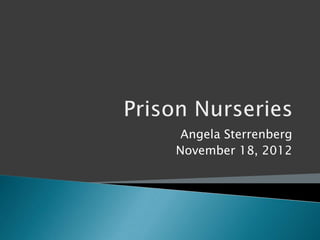
Prison nurseries
- 1. Angela Sterrenberg November 18, 2012
- 2. Definition Benefits of the Attachment Theory Statistics Recidivism Rates Programs Summary References
- 3. Prison Nursery Programs ◦ Keep the mother and infants together during the first critical months of development. Attachment ◦ Emotional closeness that children have with adults. Prison Nurseries ◦ “Housing arrangements in correctional facilities that allow incarcerated women to co-reside with her newborn and be the child’s primary care-giver.” (Byrne, M.W., Goshin, Joestl.,2011).
- 4. Emotional Safety and Development fulfillment Trust Self- Self-reliant perception
- 5. Regulate Social Behavior Break the cycle Stability Rehabilitation Higher self- esteem
- 6. • 1977-2007 the number of women in prison increased by 832% 832% • 2 million children under age 18 have a parent in prison. • Most under the age of 10. 2 million • At the time of sentencing: • 4% of women in state prison are pregnant 4% • 3% of women in federal prison are pregnant • 207,700 women were in in prison in 2008. • 6% arrive pregnant 6%
- 7. Women who have babies in prison and are separated are three times more likely to reoffend as to women who live with their babies in prison. Nursery programs work, if it can keep five women from coming back to prison, it could save $100,000-$150,000 a year. 1987-Of 70 nations only four separate imprisoned mothers from their infants. Approximately 10% of the children of incarcerated mothers are in the custody of the child welfare system.
- 8. Nebraska California • 33.3% overall population • 46% overall population • 9% program population • 22% program population Massachusetts • 10% program population
- 9. Washington • 38.9% overall population Ohio • 17% program population • 30% overall population • 17% program population New York • 26% overall population • 13% program population
- 10. Educational Support Groups Life skills Chemical dependency Parenting classes Parent and infant development Childcare Breastfeeding CPR
- 11. In conclusion….prison nursery programs are beneficial to the individual, family, and society. The attachment theory consists of bonds between the mother and child and the importance of these bonds to help them develop for the future. These programs give the mother the life tools needed to make necessary changes to break the cycle and make a better life for their family.
- 12. Byrne, M.W., Goshin, L.S. & Joestl, S.S. (2010). Intergenerational Transmission of Attachment for Infants Raised in a Prison Nursery. Retrieved on November 14, 2012 from http://www.nbci.nlm.nih.gov/pmc/articles.PMC2942021/ Carlson Jr., Joseph R. (2009). Prison Nurseries: A Pathway to Crime- Free Futures. Retrieved on November 16, 2012 from http://www.docstoc.com/docs/42958884/Prison-Nurseries-A-Pathway Ford, Allison. (2010). Bonding Behind Bars: Do Prison Nurseries Help or Hinder Parenting? Retrieved on November 6, 2012 from http://www.divinecaroline.com/33/100800-bonding-bars-do-prison- nurseries Goshin, Lorie Smith; Byrne, Mary Woods. (2009). Converging Streams of Opportunity for Prison Nursery Programs in the United States. Retrieved on November 6, 2012 from http://www.nbci.nlm.nih.gov/pmc/articles/PMC2768406/
- 13. Lilly, J. R., Cullen, F.T. & Ball, R. A. (2011). Criminological theory: Context and consequences (5th Ed.). Washington D.C: Sage Publications Stein, Deborah, Jiang. (2010). Babies Behind Bars: Nurseries for incarcerated mothers and their children. Retrieved on November 6, 2012 from http://www.cwla.org/voice/JA10babies.html Women’s Prison Association (2009). Mothers, Infants, and Imprisonment. Retrieved on November 7, 2012 from http://www.wpaonline.org Women’s Prison Association (2009). Prison Nursery Programs a Growing Trend in Women’s Prisons. Retrieved on November 14, 2012 from http://www.corrections.com/news/article/21644 Yager, Sarah. (2011). Prison Bonds: Nursery programs foster mother-child relationships behind bars. Retrieved on November 6, 2012 from http://broadrecognition.com/politics/prison-bonds-nursery-programs-foster- mother-child-relationships-behind-bars/